비버리다과
Viverridae| 비버리다과[2] | |
|---|---|
 | |
| 파라독수루스, 유전타, 파구마 및 아크틱티스 종을 포함한 비버리드 | |
| 과학적 분류 | |
| 왕국: | 애니멀리아 |
| 문: | 챠다타 |
| 클래스: | 젖꼭지 |
| 주문: | 육식동물 |
| 서브오더: | 펠리폼리아 |
| 인프라스트럭처: | 비버로이아목 |
| 패밀리: | 비버리다과 그레이, 1821년 |
| 표준속 | |
| 비베라 린네, 1758년 | |
| 속 | |
비버리다과(Verridae)는 소형에서 중형, 펠리폼 포유동물 과이다.비버리드(/va the / vaɪv/r/dz / )이 과의 이름은 [3]1821년 존 에드워드 그레이에 의해 처음 기술되었다.버버리드는 월러스 선을 넘어 아프리카, 남유럽, 남아시아와 동남아시아 전역에서 발생한다.술라웨시 섬과 인접한 몇몇 섬들에서 그들의 출현은 그들이 구세계 [4]열대 지방의 고대 거주자라는 것을 보여준다.
특성.
각 발에 네다섯 개의 발가락과 반쯤 움츠러드는 발톱을 가지고 있다.그들은 각 턱과 어금니에 6개의 앞니가 있고, 위턱에 2개의 결절 연삭기가 있고 아래턱에 1개가 있다.혀는 날카로운 가시로 거칠다.항문 아래에 주머니나 분비선이 생기지만 [3]맹장은 없다.
흑사마귀는 모든 흑사마귀과 중 가장 원시적이고 분명히 흑사마귀과보다 덜 전문적이다.외형적인 특징에서는 아래턱뼈 사이의 얼굴진동이 긴 주둥이와 다발, 그리고 첫 번째 손가락이 있는 짧은 팔다리와 다섯 개의 발가락 뒷다리로 구분된다.두개골은 상악골에 있는 구개골 후공의 위치, 거의 항상 상악골 봉합 전, 그리고 보통 제2의 전극 레벨에 따라 다르다; 그리고 명확한 홈에 의해 또는 이것이 거의 지워지지 않을 때, 부피에 의해 두 가지 요소로 청각 볼라의 뚜렷한 외부 분할에 의해 다르다.부풀어 오른 장염 앞에 있는 고막뼈의 융기일반적인 치과 공식은 3.1.4.23.1.4.2이지만, 그 수는 줄어들 수 있다. 단, Felidae와 [4]같은 정도는 아니다.
그들의 살을 깎는 육식 치아는 다른 펠리폼 [5]육식동물들에 비해 상대적으로 발달되지 않았다.대부분의 비버리드 종들은 음경 뼈를 가지고 있다.[6]
분류
생물종
1821년 그레이는 이 과를 비버라속, 제네타속, 허페스테스속, 수리카타속으로 [3]정의했다.Reginald Innes Poccock은 후에 매우 다양한 속들을 포함하고, 주로 발의 구조와 대부분의 종에 존재하며 지역에 위치한 피부에서 파생된 몇몇 고도로 특화된 향기샘의 여러 아과로 분할되기 쉽다고 재정의했다.외생장기의 기능을 합니다.그는 Hemigalinae, Paradoxurinae, Prionodontinae 및 Viverrinae를 Viverridae에 [4]종속시켰다.
1833년 에드워드 터너 베넷은 말라가시 포사(Cryptoprocta ferox)를 기술하고 크립토프록타를 비버리다에 [7]종속시켰다.DNA/DNA 교배 실험에 기초한 분자 및 형태학적 분석 결과, Cryptoprocta는 Verridae에 [8]속하지 않고 Epleridae에 속하는 것으로 나타났다.
아프리카야자사향고양이(Nandinia binotata)는 사향고양이과와 비슷하지만 유전적으로 구별되며, 자신의 단형 과인 난디니아과에 속한다.Poiana 종이 [2]verrides라는 것에는 거의 논쟁의 여지가 없다.
파라독수루스, 파구마, 헤미갈리아나를 대표하는 13종과 3종으로 구성된 29종의 카르니보라 종에 기초한 DNA 분석 결과 아프리카린상포아나가 제네타속의 자매군이라는 포콕의 추정이 확인됐다.프리오노돈은 펠리과의 자매군으로 자리매김하는 것이 강하게 뒷받침되고 있으며, 아시아린상은 단일속인 프리오노돈과에 [9]속하는 것이 제안되었다.
| 서브패밀리 | 속 | 종. | 유형종 이미지 |
|---|---|---|---|
| 비버리나과 | 비베라 린네, 1758년[11] |  | |
| 비베리쿨라속 호지슨, 1838[14] | 작은 사향고양이 (V. indica) (Geofroy Saint-Hilaire, 1803)[15] |  | |
| 시베틱티스 포콕, 1915년[16] | 아프리카사향고양이(C. civeta) (슈레버, 1776년)[17] | 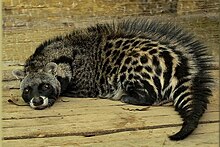 | |
| 반달팽이과 그레이, 1864[18] | |||
| 헤미갈로스속 주르단, 1837년[19] | 줄무늬야자사향고양이(H. derbyanus) Jourdan, 1837년[19] | 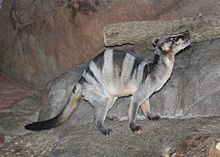 | |
| 시노게일 그레이, 1836년[20] | 오터 사향고양이 (C. benetii) 그레이, 1836년[20] | 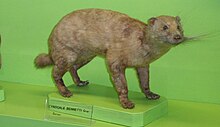 | |
| 디플로갈레 토마스, 1912년[21] | 호스의 팜 사향고양이 (D. hosi) (Thomas, 1892)[22] | 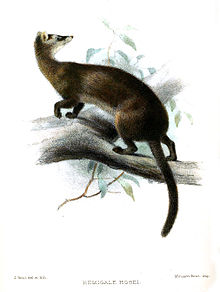 | |
| 마크로갈리디아 1910년 슈바르츠[23] | 술라웨시야자사향고양이(M. muschenbroekii) (Schlegel, 1877)[24] | 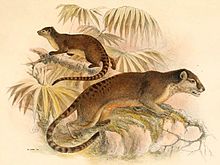 | |
| 크로토갈레 토마스, 1912년[21] | 오스턴사향고양이(C. owstoni)토마스, 1912년[21] | 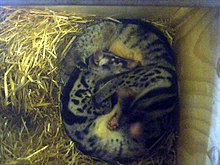 | |
| 패러독스과 그레이, 1864[18] | 패러독수루스 큐비에르, 1822[25] | 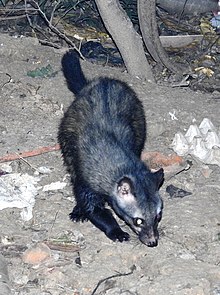 | |
| 아크틱티스 템민크, 1824년[29] | 빈투롱 (A. binturong) (Raffles, 1822)[30] | 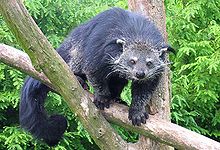 | |
| 파구마 그레이, 1831년[31] | 가면사향고양이 (P. larvata) (Smith, 1827년)[32] |  | |
| 악토갈리디아 메리암, 1897년[33] | 작은 이빨 팜 사향고양이 (A. trivirgata) (그레이, 1832)[34] |  | |
| 진달래과 | 제네타 큐비에르, 1816[35] |
|  |
| 포이아나 그레이, 1864[18] |  |
계통발생학
Viverridae의 계통학적 관계는 다음 [1][10]분해도와 같다.
| 비버리다과 |
| ||||||||||||||||||||||||||||||||||||||||||||||||||||||||||||||||||||||||||||||||||||||||||||||||||||||||||||||||||||||||||||||||||||||||||||||||||||||||||||||||||||||||||||||||||||||||||||||||||||||||||||
멸종종
| 서브패밀리 | 속 | 종. |
|---|---|---|
| 비버리나과 | 비베라 린네, 1758년 | 리키 사향고양이 (V. 리키) 리키, 1982년 |
| 세미제네타 헬빙 1927 |
| |
| 패러독스과 | 키체키아 새비지, 1965년[50] | |
| 투게닉티스 Morales & Pickford, 2005년[52][53] | § T. ngoraensis[52] Morales & Pickford, 2005년 | |
| 카누이파 Dehgani & Werdelin, 2008년[54] | § K[54]. lewisae Dehgani & Werdelin, 2008 | |
| 시아믹티스 Grohé et al., 2020[55] | § S[55]. carbonensis Grohé et al., 2020 |
「 」를 참조해 주세요.
레퍼런스
- ^ a b c Gaubert, P. & Cordeiro-Estrela, P. (2006). "Phylogenetic systematics and tempo of evolution of the Viverrinae (Mammalia, Carnivora, Viverridae) within feliformians: implications for faunal exchanges between Asia and Africa" (PDF). Molecular Phylogenetics and Evolution. 41 (2): 266–278. doi:10.1016/j.ympev.2006.05.034. PMID 16837215.

- ^ a b c Wozencraft, W. C. (2005). "Family Viverridae". In Wilson, D. E.; Reeder, D. M. (eds.). Mammal Species of the World: A Taxonomic and Geographic Reference (3rd ed.). Johns Hopkins University Press. pp. 548–559. ISBN 978-0-8018-8221-0. OCLC 62265494.
- ^ a b c Gray, J. E. (1821). "On the natural arrangement of vertebrose animals". London Medical Repository. 15 (1): 296–310.
- ^ a b c Pocock, R. I. (1939). "Family Viverridae". The Fauna of British India, including Ceylon and Burma. Vol. Mammalia. – Volume 1. London: Taylor and Francis. pp. 330–332.
- ^ Wozencraft, W. C. (1984). Macdonald, D. (ed.). The Encyclopedia of Mammals. New York: Facts on File. pp. 134–135. ISBN 0-87196-871-1.
- ^ Ewer, R. F. (1998). The Carnivores. Cornell University Press. ISBN 0-8014-8493-6.
- ^ Bennett, E. T. (1833). "Notice of a new genus of Viverridous Mammalia from Madagascar". Proceedings of the Zoological Society of London. 1833: 46.
- ^ Veron, G.; Catzeflis, F. M. (1993). "Phylogenetic relationships of the endemic Malagasy carnivore Cryptoprocta ferox (Aeluroideae): DNA/DNA hybridization experiments". Journal of Mammalian Evolution. 1 (3): 169–185. doi:10.1007/bf01024706. S2CID 21555307.
- ^ Gaubert, P.; Veron, G. (2003). "Exhaustive sample set among Viverridae reveals the sister-group of felids: the linsangs as a case of extreme morphological convergence within Feliformia". Proceedings of the Royal Society B: Biological Sciences. 270 (1532): 2523–2530. doi:10.1098/rspb.2003.2521. PMC 1691530. PMID 14667345.
- ^ a b Nyakatura, K. & Bininda-Emonds, O. R. P. (2012). "Updating the evolutionary history of Carnivora (Mammalia): a new species-level supertree complete with divergence time estimates". BMC Biology. 10: 12. doi:10.1186/1741-7007-10-12. PMC 3307490. PMID 22369503.
- ^ a b Linnaeus, C. (1758). "Viverra". Systema naturæ per regna tria naturæ, secundum classes, ordines, genera, species, cum characteribus, differentiis, synonymis, locis 1 (Tenth ed.). Stockholm: Laurentius Salvius. pp. 43–45.
- ^ Gray, J. E. (1832). "On the family of Viverridae and its generic sub-divisions, with an enumeration of the species of several new ones". Proceedings of the Committee of Science and Correspondence of the Zoological Society of London. 2: 63–68.
- ^ a b Blyth, E. (1862). "Report of Curator, Zoological Department, February 1862". The Journal of the Asiatic Society of Bengal. 31 (3): 331–345.
- ^ Hodgson, B. H. (1838). "Classified Catalogue of Nepalese Mammalia". Annals of Natural History. 1 (2): 152−154.
- ^ Geoffroy Saint-Hilaire, E. (1803). "La Civette de l'Inde". Catalogue des Mammifères du Museum National d'Histoire Naturelle. Paris: Museum National d'Histoire Naturelle. p. 113.
- ^ Pocock, R. I. (1915). "On the Feet and Glands and other External Characters of the Viverrinae, with the description of a New Genus". Proceedings of the Zoological Society of London: 131−149.
- ^ Schreber, J. C. D. (1778). "Die Civette Viverra civetta". Die Säugethiere in Abbildungen nach der Natur, mit Beschreibungen. Erlangen: Wolfgang Walther. pp. 418–420.
- ^ a b c Gray, J. E. (1864). "A revision of the genera and species of viverrine animals (Viverridae), founded on the collection in the British Museum". Proceedings of the Zoological Society of London for the Year 1864: 502–579.
- ^ a b Jourdan, C. (1837). "Mémoire sur deux mammifères nouveaux de l'Inde, considérés comme types des deux genres voisins des Paradoxures, genres Hémigale et Ambliodon". Comptes rendus hebdomadaires des séances de l'Académie des sciences: 442–447.
- ^ a b Gray, J.E. (1836). "Characters of some new species of Mammalia in the Society's collection". Proceedings of the Zoological Society of London. Part IV (October): 87–88.
- ^ a b c Thomas, O. (1912). "Two new Genera and a Species of Viverrine Carnivora". Proceedings of the Zoological Society of London. Part II: 498–503.
- ^ Thomas, O. (1892). "On some Mammals form Mount Dulit, North Borneo". Proceedings of the Zoological Society of London. Part I: 221–226.
- ^ Schwarz, E. (1910). "Notes on some Palm-Civets". The Annals and Magazine of Natural History; Zoology, Botany, and Geology. 8. 5 (29): 422–424.
- ^ Schlegel, H. (1879). "Paradoxurus musschenbroekii". Notes from the Royal Zoological Museum of the Netherlands at Leyden. 1 (Note XIV): 43.
- ^ Cuvier, F. (1822). "Du genre Paradoxure et de deux espèces nouvelles qui s'y rapportent". Mémoires du Muséum d'Histoire Naturelle Paris. 9: 41–48.
- ^ Pallas, P. S. (1778). "Das Zwitterstinkthier". In Schreber, J. C. D. (ed.). Die Säugethiere in Abbildungen nach der Natur, mit Beschreibungen. Erlangen: Wolfgang Walther. p. 426.
- ^ Pallas, P. S. (1778). "Der Boshond". In Schreber, J. C. D. (ed.). Die Säugethiere in Abbildungen nach der Natur, mit Beschreibungen. Erlangen: Wolfgang Walther. p. 451.
- ^ Blanford, W. T. (1885). "A Monograph of the Genus Paradoxurus, F. Cuvier". Proceedings of the Zoological Society of London. 53 (4): 780–808. doi:10.1111/j.1096-3642.1885.tb02921.x.
- ^ Temminck, C. J. (1824). "XVII Genre Arctictis". Monographies de mammalogie. Paris: Dufour & d'Ocagne. p. xxi.
- ^ Raffles, T. S. (1822). "XVII. Descriptive Catalogue of a Zoological Collection, made on account of the Honourable East India Company, in the Island of Sumatra and its Vicinity, under the Direction of Sir Thomas Stamford Raffles, Lieutenant-Governor of Fort Marlborough', with additional Notices illustrative of the Natural History of those Countries". The Transactions of the Linnean Society of London. XIII: 239–274.
- ^ Gray, J. E. (1831). "Paguma". Proceedings of the Committee of Science and Correspondence of the Zoological Society of London. Vol. 1. London: Zoological Society of London. p. 95.
- ^ Smith, C.H. (1827). "Gulo larvatus, the Masked Glutton". In Griffith, E. (ed.). The animal kingdom : arranged in conformity with its organization. Vol. 2. Mammalia. London: G.B. Whittaker. p. 281.
- ^ Merriam, C. H. (1897). "The generic names Ictis, Arctogale, and Arctogalidia". Science. 5 (112): 302. doi:10.1126/science.5.112.302. PMID 17741859.
- ^ Gray, J.E. (1832). "On the Family of Viverridae and its generic subdivisions; with an enumeration of the Species of Paradoxurus, and Characters of several new ones". Proceedings of the Committee of Science and Correspondence of the Zoological Society of London (Part 2): 63–68.
- ^ Cuvier, F. (1816). Cuvier, G. (ed.). Le règne animal distribué d'après son organisation, pour servir de base à l'histoire naturelle des animaux et d'introduction à l'anatomie comparée. Vol. I. Paris: Deterville.
- ^ Linnaeus, C. (1758). "Viverra genetta". Systema naturæ per regna tria naturæ, secundum classes, ordines, genera, species, cum characteribus, differentiis, synonymis, locis 1 (Tenth ed.). Stockholm: Laurentius Salvius. p. 45.
- ^ Schreber, J. C. D. (1778). "Die Bisamkaze Viverra tigrina". Die Säugethiere in Abbildungen nach der Natur mit Beschreibungen. Vol. Dritter Theil. Erlangen: Walther. pp. 425–426.
- ^ Thunberg, C. P. (1811). "Beskrifning och teckning pa Viverra felina". Kungliga Swenska Wetenskaps Academiens Handlingar: 165–168.
- ^ Gray, J. E. (1828). "Viverra maculata". Spicilegia zoologica : original figures and short systematic descriptions of new and unfigured animals. London: Treuttel, Wurtz & Co. p. 9.
- ^ Geoffroy Saint-Hilaire, I. (1832). "Descriptions d'une nouvelle espèce du genre Genette. Genetta. Cuv.". Études Zoologiques : Ouvrage comprenant l'histoire et la description d'un grand nombre d'animaux récemment découverts et des observations nouvelles sur plusieurs genres déjà connus. Paris: Lequien Fils. p. 73.
- ^ Rüppell, E. (1835). "Viverra abyssinica. Rüppell". Neue Wirbelthiere zu der Fauna von Abyssinien gehörig. Frankfurt: Siegmund Schmerber.
- ^ Waterhouse, G. R. (1838). "On some New Species of Mammalia from Fernando Po". Proceedings of the Zoological Society of London: 57–61.
- ^ Thomas, O. (1901). "On the more notable Mammals obtained by Sir Harry Johnston in the Uganda Protectorate". Proceedings of the Zoological Society of London. II: 85–90.
- ^ Matschie, P. (1902). "Über die individuellen und geographischen Abänderungen der Ginsterkatzen". Verhandlungen des V. Internationalen Zoologen-Congresses zu Berlin, 12.–16. August 1901. Jena: Gustav Fischer. pp. 1128–1145.
- ^ Thomas, O. & Schwann, H. (1906). "The Rudd Exploration of South Africa.—IV. List of Mammals obtained by Mr. Grant at Knysna". Proceedings of the Zoological Society of London. 76 (1–2): 159–168. doi:10.1111/j.1469-7998.1906.tb08427.x.
- ^ Allen, J. A. (1919). "Preliminary notes on African carnivora". Journal of Mammalogy. 1 (1): 23–31. doi:10.2307/1373716. JSTOR 1373716.
- ^ Gaubert, P. (2003). "Description of a new species of genet (Carnivora; Viverridae; genus Genetta) and taxonomic revision of forest forms related to the Large-spotted Genet complex". Mammalia. 67 (1): 85–108. doi:10.1515/mamm.2003.67.1.85. S2CID 84351854.
- ^ Thomson, T. R. H. (1842). "Description of a new species of Genetta, and of two species of Birds from Western Africa". The Annals and Magazine of Natural History; Zoology, Botany, and Geology. 10 (64): 203–205. doi:10.1080/03745484209445224.
- ^ Pocock, R. I. (1907). "Report upon a Small Collection of Mammalia brought from Liberia by Mr. Leonard Leighton". Proceedings of the Zoological Society of London (November): 1037–1046.
- ^ a b Savage, R. J. G. (1965). "Fossil mammals of Africa: 19, The Miocene Carnivora of East Africa". Bulletin of the British Museum (Natural History). 10 (8): 239–316.
- ^ Adrian, B.; Werdelin, L. & Grossman, A. (2018). "New Miocene Carnivora (Mammalia) from Moruorot and Kalodirr, Kenya" (PDF). Palaeontologia Electronica. 21 (1 10A): 1–19. doi:10.26879/778.
- ^ a b Morales, J. & Pickford, M. (2005). "Carnivores from the Middle Miocene Ngorora Formation (13-12 Ma), Kenya" (PDF). Estudios Geológicos. 61 (3–6): 271–284. doi:10.3989/egeol.05613-668.
- ^ Werdelin, L. (2019). "Middle Miocene Carnivora and Hyaenodonta from Fort Ternan, western Kenya" (PDF). Geodiversitas. 41 (6): 267. doi:10.5252/geodiversitas2019v41a6. S2CID 146620949.
- ^ a b Dehghani, R. & Werdelin, L. (2008). "A new small carnivoran from the Middle Miocene of Fort Ternan, Kenya". Neues Jahrbuch für Geologie und Paläontologie - Abhandlungen. 248 (2): 233–244. doi:10.1127/0077-7749/2008/0248-0233.
- ^ a b Grohé, C.; Bonis, L. D.; Chaimanee, Y.; Chavasseau, O.; Rugbumrung, M.; Yamee, C.; Suraprasit, K.; Gibert, C.; Surault, J.; Blondel, C.; Jaeger, J.-J. (2020). "The Late Middle Miocene Mae Moh Basin of Northern Thailand: The Richest Neogene Assemblage of Carnivora from Southeast Asia and a Paleobiogeographic Analysis of Miocene Asian Carnivorans". American Museum Novitates (3952): 1–57. doi:10.1206/3952.1. S2CID 219296152.



